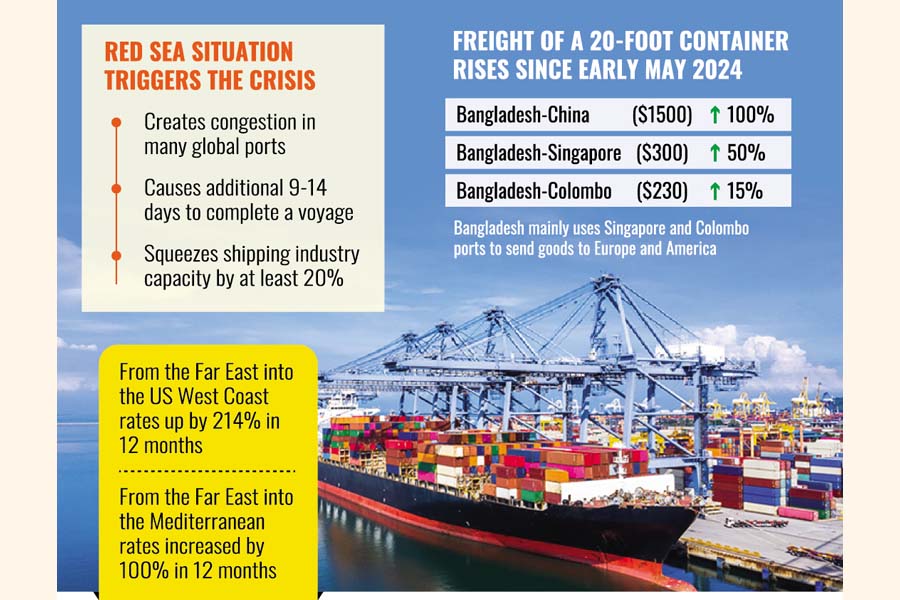Freight container spot rates mounting
Shipping industry insiders fear it may again reach the level of Covid period

Published :
Updated :

Spot rates of ocean freight containers to and from Bangladesh have been rising since the start of May, prompting speculation that it may reach the Covid period when it trebled.
Top shipping executives in Bangladesh told the FE that this is mainly due to the Red Sea situation and congestion in many global ports. Such problems take additional time to complete a voyage.
The ocean vessels now reroute voyages away from the waters off Yemen after facing attacks from the Iran-backed Houthi militias.
Diverting vessels from Asia and bound for Europe around the Cape of Good Hope adds an additional nine to 14 days to voyage times.
Mr Fayyaz Khundker, CEO and Managing Director at the Ocean Network Express (Bangladesh), told the FE that the shipping industry now required an additional 10 days to complete a trip due to the Red Sea situation.
Consequently, there is at least a 20-percent "squeeze in capacity" in the industry, leading to a rise in the rates.
He said that such a rise in the spots has implications for the country's trade as the people will have to pay for the imported goods.
On the other hand, the exporters will also lose its profitability as the buyers will adjust the increased rates with the goods.
Currently, a 20-foot container requires at least $1500 to ply between Bangladesh and China, up by around 100-percent rise since early May. China is the biggest trade partner of Bangladesh, having over $25-billion bilateral trade.
Bangladesh and Singapore has increased by 50 per cent to $300 for a 20-foot container.
The Bangladesh-Colombo route, however, surged more than 15 per cent to $ 230 to carry a container.
Usually, Bangladesh mainly uses Singapore port followed by Colombo to send its goods to Europe and America.
"To my mind, the Red Sea situation is putting pressure on shipping capacity, leading to fuelling up of the freights," said Captain AS Chowdhury, country head of the Sea Consortium, a leading feeder line between Bangladesh and Singapore.
He said there is a new panic among many shipping lines that it may again reach as the Covid period when the freights rose significantly mainly due to lack of containers.
He said this is not Bangladesh's own problem rather it is a global shipping problem.
Pirate attacks off Somalia, on Africa's eastern coast, have increased in recent times, he said, adding that a Bangladeshi ship was attacked and released recently after the pirates got a handsome ransom.
From the Far East into the US West Coast, rates have increased by 29 per cent since the start of April ($ 3456) to stand at $4 468 per FEU (40-foot equivalent units) on 16 May. This is 214 per cent higher than 12 months ago ($1 422), according to an international media.
The media also said from the Far East into the Mediterranean, rates have increased by 22 per cent since 1 April ($4 144) to stand at $5,044 on 16 May - an increase of 100 per cent compared to 12 months ago ($2521).
"From the Far East into the US East Coast, rates have increased by 21 per cent since 1 April ($4 617) to stand at $5 584 on 16 May - an increase of 129 per cent compared to 12 months ago ($2434)," the media said.
In the Americas, a drought has forced the Panama Canal Authority to reduce the number of daily transits between the Atlantic and Pacific oceans and to set limits on vessels' draft - the maximum depth of the hull below the waterline.
In the meantime, the Reliance Shipping, which had started on an ad-hoc shipping service between Bangladesh and Europe during high spots in the Covid period, told the FE that they have planned to launch a new service between China and Bangladesh.
"We've planned to launch a new line shortly," said Mohammad Rashed, chairman of the Reliance Shipping and Logistics Limited.
jasimharoon@yahoo.com


 For all latest news, follow The Financial Express Google News channel.
For all latest news, follow The Financial Express Google News channel.